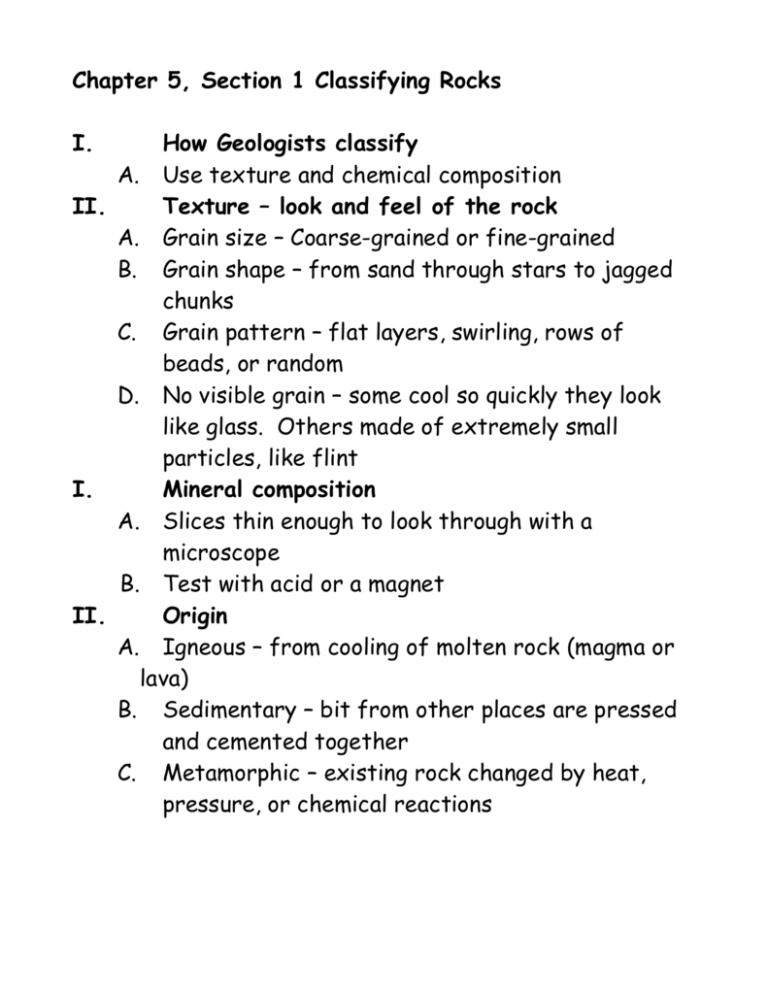Chapter 5, Section 1 Classifying Rocks
advertisement

Chapter 5, Section 1 Classifying Rocks I. How Geologists classify A. Use texture and chemical composition II. Texture – look and feel of the rock A. Grain size – Coarse-grained or fine-grained B. Grain shape – from sand through stars to jagged chunks C. Grain pattern – flat layers, swirling, rows of beads, or random D. No visible grain – some cool so quickly they look like glass. Others made of extremely small particles, like flint I. Mineral composition A. Slices thin enough to look through with a microscope B. Test with acid or a magnet II. Origin A. Igneous – from cooling of molten rock (magma or lava) B. Sedimentary – bit from other places are pressed and cemented together C. Metamorphic – existing rock changed by heat, pressure, or chemical reactions Chapter 5, Section 2 Igneous Rocks I. Characteristics of igneous rock A. Origin – Ignis means fire i. Extrusive rock is from lava (on surface). Basalt is most common example ii. Intrusive rock formed under the surface. Granite is most common example B. Texture – size and shape of crystals i. Fine-grained from rapid cooling; coarsegrained from slow cooling ii. Intrusive rocks have larger crystals iii. Porphyritic texture is large crystals in a background of much smaller crystals – cooling in 2 stages, like when close to surface iv. Basalt crystals too small to be seen without a microscope C. Mineral composition – color can change depending on what is mixed in with rock II. Uses of igneous rock A. Tools and building materials B. Granite monuments are more than 3,500 year old C. Basalt used in gravel for roads D. Pumice for cleaning and polishing (soap called “Lava”) Chapter 5, Section 3 Sedimentary Rocks I. II. From sediment to rock A. Sediment is small, solid particles that come from rock or living things B. Erosion – running water or wind break off and carry away particles C. Deposition – particles are deposited (dropped) when wind or water slows i. More sedimentary rock in lakes and deltas than rivers ii. Living remains may harden, and then be called fossils D. Compaction – as layers build up, pressure is created, squishing the particles together. Layers may remain visible E. Cementation – even compacted stuff will fall apart if there is no glue. Minerals dissolved in water may seep into the spaces between particles and crystallize, acting as glue Clastic rocks A. Rock fragments squished together B. Shale – from tiny particles of clay, deposited in very thin layers C. Sandstone – from the sand on beaches, etc. D. Conglomerate and Breccia – mixture of rock particles of different sizes. Conglomerate has rounded edges; breccia has sharp edges. III. Organic rocks A. Coal – from swamp plants buried under water B. Limestone – from shells made of calcite (coral, clams, etc.). Some calcite dissolves to form cement. Chalk is one example IV. Chemical rocks A. When minerals crystallize out of a solution. B. Some limestone is chemical – stalactites are an example C. Rock salt and gypsum are both chemical rocks formed from evaporation of water V. Uses of sedimentary rocks A. Sandstone and limestone as building materials – easy to shape but not very durable B. Limestone for smelting, and in concrete Chapter 5, Section 4 Rocks from Reefs I. Living coral A. Relatives of jellyfish, who make skeletons that grow together B. Only in shallow, warm, saltwater II. How a coral reef forms A. Coral change calcium to calcite, to put in skeletons B. Fringing reefs (close to shore); barrier reefs (at least 10k out); and atolls (ring shaped island far from land). a. Atolls form on top on drowned volcano. III. Limestone deposits from coral reefs A. When coral is buried, the calcite turns into limestone. Later, uplift exposes the limestone Chapter 5, Section 5 Metamorphoric Rocks I. How they form A. Heat and pressure can change any rock into metamorphic rock (including metamorphic rock). B. Pressure is hundreds or thousands times surface pressure II. Classifying metamorphic rocks A. Use arrangement of grains B. Foliated (from word for leaf) means arranged in thin, parallel layers. They split into layers. Slate is an example. C. Non-foliated rock has random grains. These do not split into layers. Marble is an example. III. Uses of metamorphic rocks A. Marble for buildings and statutes. B. Slate for flooring, roofing, and chalkboards. Chapter 5, Section 6 The Rock Cycle I. Many pathways A. Forces build, destroy, and change the rocks in the crust. a. Rock cycle is the processes that change rock b. Constructive and destructive forces, including plate tectonics. II. One pathway A. Granite batholith formed, then pushed upward by mountain building forces. B. Erosion wears away sand particles, and the particles collect and ultimately form sedimentary rock (sandstone). C. As it is pushed downward, heat and pressure start to build. Eventually the sandstone will metamorphize into quartzite. D. The quartzite could be uplifted to the surface, or melt and return as magma. III. The rock cycle and plate tectonics A. Plate movements drive the rock cycle. B. Subducting oceanic plates – push igneous or sedimentary rock down into mantle, where it comes back to the surface as magma. C. Colliding continental plates – can power metamorphic process and provide force for uplift.









